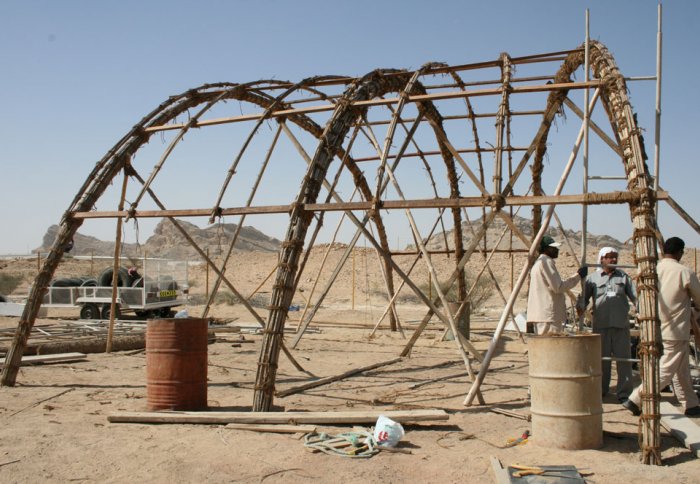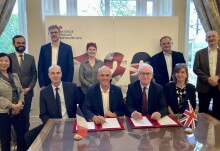
Tests carried out by Sandra Piesik in Al Ain, UAE, 2009 © Sandra Piesik

A collaborative project involving Imperial and the UAE is assessing the potential of date palm leaves as a renewable, low-carbon building material.
Phoenix dactylifera, or the date palm tree, is perhaps best known for its sweet fruit but, as growers in the United Arab Emirates (UAE) have known for thousands of years, its leaves can also be used in construction.
A collaborative project involving Imperial, UAE, Buro Happold Consultants and architect Sandra Piesik of 3 Ideas Ltd is now looking at expanding the use of the leaves as a renewable, low-carbon building material.

Left to right: Wolf Mangelsdorf (Buro Happold), His Highness Sheikh Mohammed bin Maktoum Al Maktoum, Dr Sunday Popo–Ola (Imperial College London), Sandra Piesik (3 ideas Ltd)
On 5 June, His Highness Sheikh Mohammed Bin Maktoum Al Maktoum, First Secretary of the UAE Embassy, visited the Structures Laboratories in the Department of Civil and Environmental Engineering where the innovative work is being carried out.
Known for his keen interest in evidence-based eco-technology, His Highness observed testing of palm leaf structures using rigs normally applied to steel.

Testing of date palm leaf structures
Dr Sunday Popo-Ola (Civil and Environmental Engineering), who is leading the work, said: “This is the first opportunity to evaluate the structural characteristics of the date palm leaf material and determine its structural performance. These properties can then be used to invent modern, more ambitious versions of traditional palm leaf structures”.
This is the first opportunity to evaluate the structural characteristics of the date palm leaf material
– Dr Sunday Popo-Ola (Civil and Environmental Engineering)
His Highness noted that scientific testing on the leaves could influence date palm leaf industries in the UAE, as well as in other countries in the region.
Going far beyond their traditional use in thatching and cladding, tests have shown that the palm leaf structures have an impressive ‘bounce back’, even after repeated loading and unloading, which confirms their potential for eco-structures.
Demonstration projects are now being planned, the first of which is likely to be a food shelter, where a large-spanned palm leaf structure could offer weather protection for harvests in countries where the logistics of food storage are critical for food security.
Article text (excluding photos or graphics) available under an Attribution-NonCommercial-ShareAlike Creative Commons license.
Photos and graphics subject to third party copyright used with permission or © Imperial College London.
Reporter
Andrew Czyzewski
Communications Division

Contact details
Email: press.office@imperial.ac.uk
Show all stories by this author




Leave a comment
Your comment may be published, displaying your name as you provide it, unless you request otherwise. Your contact details will never be published.